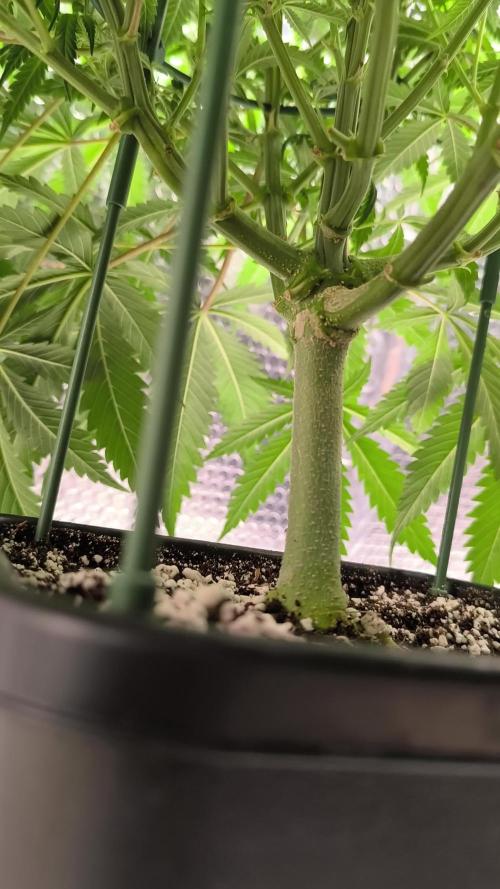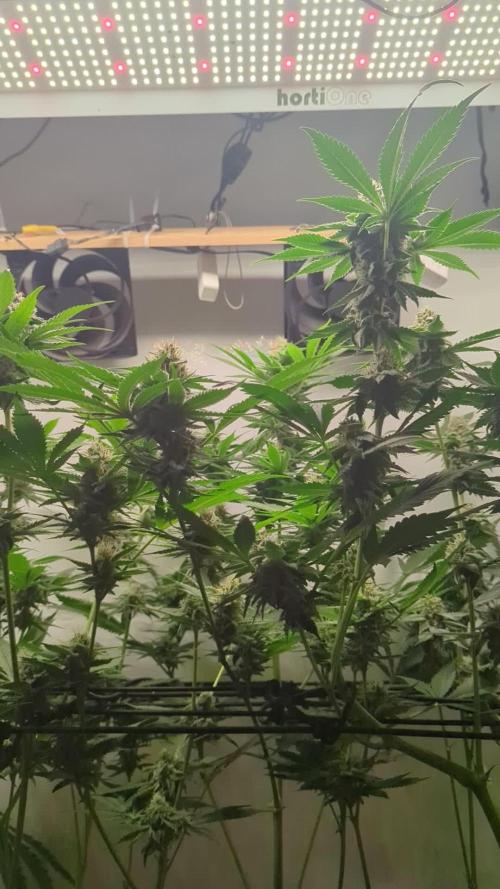The Grow Awards 2026 🏆 



































Likes
Comments
Share


@Kingseeds
Follow
Dark purple buds and frozen cola
Finish in 67 days
She needs normal light and feeding
Likes
26
Share


@BigBadLion
Follow
Week 4!
We're getting close to flower and so far everything looks well!
This is what happened in this week:
- I did some LST! 😁
- I increased the amount of nutrients and it seems the girls like it!
- The plant on the front is growing more than the one on the back, even when both might look about the same in the timelapse.
I also think they need more water. It feels (I could be wrong here) the roots are not reaching the bottom of the pot and I fear they might get root-bound because of that.
So next week I'll saturate the pot with water and I'll probably try to tuck some of the fan leaves, the lower branches need some more light. 👌
Thanks for reading and see you all next week! 😃
Likes
9
Share


@Josh9260
Follow
Had the seed capsule stick to the seedling, making it bend but it fixed itself and had no issues afterwards.
Likes
16
Share


@Chocolopeison
Follow
Comenzamos la floración con estas chicas, estoy muy encantado con ellas la verdad para que les voy a mentira, muy ansioso de empezar a ver sus flores, pretendemos fertilizar solo hasta la semana 5 por ahora. Estamos solo con 1 riego diario estuvimos de 1L ahora lo subimos 2L y lo recibieron muy bien.
Algo en particular es que estamos probando cannaboost folear, se lo estamos dando 3 veces por día a la planta hace 10 días y no vamos a parar hasta el día 21 de floración para luego cambiar a dosis radicular, estamos haciendo esto para economizar cannaboost y comparar resultados con su dosis full que ya la eh testeado.
A las nenas se les hizo super cropping (en mi instagram pueden ver un tutorial @chocolopeison) hace 7 días a las cuales también le agregamos unos soportes y hoy ya la pasamos a floración recuperadas con una gran defoliación de bajos. Ahora esperaremos día 14 para hacer otra defoliación, super cropping y guiado de malla que pronto estaremos instalando.
La iluminación estamos con 540W de qb (2 @heavengrowlight y 1 @meijiu)
Likes
19
Share


@GoldenWeedGrower
Follow
Legend
Timestamp: 📅
Measures: 🛠️
Water: 🌊
Actions: 💼
Thoughts: 🧠
Events: 🚀
________________________________
📅 D43/F04 - 05/10/23 - ,
🛠️ EC 1.1 pH 6.4
🌊 Added 2L of water and nutes
💼 Big Defolation
🧠
🚀
________________________________
📅 D44/F05 - 06/10/23
🛠️
🌊 RES Changed 💦💦💦
💼
🧠 I'll let her run pure water 'til tomorrow
🚀
________________________________
📅 D45/F06 - 07/10/23
🛠️ EC 1.1 pH 6.5
🌊 New water
💼 Defolation and HST on the litte one
🧠
🚀
________________________________
📅 D46/F07 - 08/10/23
🛠️ EC: 1.1, pH 6.4
🌊 Added 5L of water and nutes
💼 LST and defolation on the little one
🧠
🚀
________________________________
📅 D47/F08 - 09/10/23
🛠️ EC1.2, pH 6.4
🌊 Added 3L of water and nutes
💼 Increased EC from 1.1 up to 1.2 adding only B52. Made a Timelapse of the little one
🧠
🚀
________________________________
📅 D48/F09 - 10/10/23
🛠️ EC: 1.3 , pH 5.5
🌊 Added 4L and nutes
💼 Eliminated lot of sprouts of the little one and lollipopping on the big one. Added water and raised EC up to 1.3 from 1.1
🧠 Very hungry and thirst girls. pH decresead drastically and it can be a problem
🚀
________________________________
📅 D49/F10 - 11/10/23
🛠️ EC: 1.3 stable pH 5.1 decreasing
🌊
💼 Strouts cutted and LST on the little one. Also raised the lamp. No water added
🧠 The little one is ready to bloom, I need to change the water and put bloom nutes, also to support the big one. I think I'm going to do it tomorrow or in a couple of days
🚀
Likes
14
Share


@pHilosophy420
Follow
Day 56 - she is drinking water like dragon and will be a monster. 5cm stretch this week and everything is well so for, looking forward to see future weeks.
Processing
Likes
14
Share


@Bluntblazer66
Follow
Sept 20th
Moved to a new res with 2 other flavours. The one in the middle is critical daddy purple, the one at the front is cement shoes
I stopped topping after the second cut so I’m focusing on 4 main colas
I put this res on its own air pump and I am using all 4 air outlets
I have also put in a pump with spray manifold, as well as insulating the complete res including the lid
Likes
151
Share


@BioBuds
Follow
These XtraKush are also finally starting to grow. It took them a while but they doubled in a week. Still a little bit pale compared to the other two strains.
With a new top layer of first worm castings and then neutral organic cocopeat to combat the gnat problem and we seem to have fixed most problems.
Temps are going down at night, I'm trying to fix this by keeping it warmer in the attic where the grow is.
In the coming week, I'm going to train/manifold them, they are getting a bit big.
Check out the great discounts on mars-hydro.com
Contact @MarsHydroLED for special offers!
Likes
11
Share


@SonomaSungrown
Follow
Not much to say here.
Everything looking strong after recovering from a brief black aphid attack (diatomaceous earth was applied).
Vegetative growth is accelerating as the roots fill out the pot.
They should really take off next week.
6/30
Seeing daily development now, and the plants are showing more and more vigor.
Excited to watch these two develop for the next couple of weeks.
Should be aggressive.
;)
Likes
11
Share


@ChefSpliff
Follow
Nothing amazing other than some swelling we are here on our last week will be chopping her down in the next week or so im tooo excited for this yield. Hoping for a a 3oz min.
Likes
9
Share


@eldruida_lamota
Follow
Que hay familia, estamos de nuevo actualizando, y es que traigo la quinta semana de floración de las Kritical de la web de GrowBarato.
En este diario dejare más imágenes ya que tengo algún ejemplar más.
El color es correcto las carencias ya las solvente.
Van progresando adecuadamente todas sus flores, esta semana añadiré el ExplotaCogollos de Agrobeta.
Ya os comenté que estamos en la recta final y una vez solucionadlas las carencias solo les queda engordar y compactar bien.
Agrobeta:
https://www.agrobeta.com/agrobetatiendaonline/36-abonos-canamo
Mars hydro:
Code discount: EL420
https://www.mars-hydro.com/
Las maximas de temperatura no superan los 25 grados y las mínimas no bajan 20, así que no me puedo quejar.
Los niveles de humedad también son los correctos van entre 50%/65% de humedad relativa.
Por supuesto el Ph lo estamos dejando alrededor de 6.
Hasta aquí es todo, buenos humos 💨💨💨.
Likes
15
Share


@Chubbs
Follow
What up grow fam. Weekly update on these three. One of them is ready for the chop this week and the other two don't look far behind. I'm excited to sample this one as the flower are mesmerizing with trichs all over.
All in all Happy Growing
Likes
48
Share


@Troy_McClure
Follow
Feb. 17
Ph 7.5
Moist
- plucked all the bad leaves that were ready
- Removed all the dead leaves
- 3 gal of water ph of 6.4 + 15 ml big bloom + 20 ml tiger bloom + 9ml apple cider vinegar + 30ml blackstrap molasses unsulphured
- Light burn seems to be the #1 problem, then ph fluctuations and nutrient burn
- I think i held the measuring cup a little awkward most feedings instead of having it on a level surface and I probably overfed by 5ml each time
- Most of the bottom leaves are green but have burnt tips, they are usually pretty attached
- the middle section has lots of dead leaves but they are tiny little ones that have burnt and fallen off
- the top leaves are all yellow on plant 1, with burnt tips, clawing up, very red stems, and are fairly easy to pluck off, not much effort on most
- the most green areas are semi-shaded and off on the edges of the tent, and all the shaded areas remained green
- Therefore, I would say my #1 problem was light burn, which made the ph fluctuations worse, nutrient deficiencies worse, and i over compensated and did not measure precisely causing nutrient burn
- there is also some wind burn on the bottom areas
- all in all the buds are developing nicely and bulking up decent amounts on plant 1, especially with all the topping
- good trichomes coming out
- plant 2 has different light burn but the leaves are praying up, and pointing up much more, more rusting also but they are not easy at all to pull off
- the buds on plant 2 are also not growing nearly as well but the trichomes seem nicer and it seems to have more
- the buds hopefully are more dense despite being small, they do look compact though
- roughly 100 bud sites visible from the top of the canopy
feb. 18
- ph. 7.2
- the clawing up and yellowing and burning of the tips has continued, likely past problems continuing to persist
- these problems really only exist on the top set of leaves, which always brings me back to light burn
- plucked another 10-15 clawed and burnt leaves from plant 1
- the buds got bigger, and the trichomes continue to pack on
- seeing more promising growth/ recovery from plant 2
- trichomes appear to be quite clear, no signs of amber
- The crop king seeds guide suggests 8 weeks of flowering time, we are a couple days into week 7 right now but the pistils are still about 60% white and somewhat straight, and the trichomes are quite clear. This would lead me to believe about 2 full weeks is left and likely closer to 2.5 weeks.
- Trying to plan out my flush, leaving me a full 7-10 days to have the plants finish their nutrients, that flush would best occur at the mid point next week
- I am expecting the trichomes to be cloudy by mid week 8, around feb. 25, I would flush them, and look to harvest 7-10 days later, around mar. 4-8
feb. 19
- ph 6.8
- moist
- definitely bulked up more, plant 2 is back and growing strong, damage on top canopy continues to burn and curl, yellowing a growing splotchy brown spots, but I am very confident that this is past damage from light burn which has since been fixed by dropping the watts down by 140
- more pistils are going orange
feb. 20
- buds fatting up really nice
Feb. 21
- Daytime temps reduced to low 70s
feb.22
- ph. 7.5
- moist
- will water tomorrow
- trichomes not yet fully cloudy
- mostly orange pistils
- mostly curled inward pistils, lower down popcorn still white and straight
- excellent trichomes on plant 2
- will feed tomorrow then I expect the next thing will be to flush so this will likely be the last feed
- daytime temps now 70-77
- nightime 65 +/-1F
feb. 23
- plants look very thirsty, leave shriveling from before but hanging down and not perky at all
- Dirt is very dry, moisture meter reads moist 5/10
- Ph: 7.6
- The plant is very hungry
- Some noticeable stretching or just more visible now
- Buds look to continue getting fatter and look really nice
- 4 gal of water ph = + 22ml of big bloom + 30ml of tiger bloom + 30ml of blackstrap molasses + 9ml of apple cider vinegar
- plucked more super dead leaves
-
Expected dates:
- feb. 25 (week 8)
- expected cloudy trichomes:
- feb. 25 (week 8)
- expected flush date:
- feb. 25
- expected harvest date
- mar. 4-8
Specifications:😎👇
Seeds:
- 2x White Widow feminized seeds from Crop King Seed
Tent:
- 4x4x6 Mammoth Grow tent
LED:
- 2x Spider Farmer SF1000 LED for veg
- 4x Spider Farmer SF1000 LED for flower (190 watts - 50-40-50-50 back left, back right, front left, front right)
Pots:
- 2x 0.5 L starter pots
- 2x 5 gal smart pots after transplant
Soil:
- Pro-mix containing mycorrhizae and perlite, used for starter pots and mixed at roughly 1:3 ratio with Ocean Forest
- Fox Farm Ocean Forest soil, used in the 5 gallon pots and mixed with roughly 3:1 ratio with pro-mix
- note: pro mix was mixed thoroughly with ocean forest in the 5 gal pot, then pro-mix was used on the top layer, in and around where the transplant will be to help the early veg stage avoid getting too "hot" via nutrients.
Nutrients:
- Fox Farm Big Bloom
- Fox Farm Big Grow
- Fox Farm Tiger Bloom
- Wholesome - Blackstrap organic unsulphured molasses
Inline Fans:
- AC Infinity CLOUDLINE T6 6" (exhaust)
- AC infinity CLOUDLINE S6 6" (active intake)
- AC infinity 6" ducting
Mini fans:
- 2x Wind Devil 6" fans
Carbon Filter:
- 2x iPower Carbon Filter on both inline fans
- note: carbon filter on intake fan as basement had mold issues in furnace room far removed but same floor, some mold issue in other room, cat litter in basement, thus, avoiding all risks and sleeping sound at night :) all mold was killed, scrubbed, cleaned, sprayed, painted, and sprayed again before setting up.
Humidifier:
- TaoTronics Cool Mist Humidifier
Dehumidifier:
- Frigidaire 30-Pint 3-Speed Dehumidifier
Timers:
- 2x VIVOSUN dual Digital Timer
- 2x Kuman Digital Timer
Likes
78
Share


@Hou_Stone
Follow
👌It’s progressing, slowly but surely for my 4 young banana krumble 👶🍌
For this grow, I plan to let each plant grow with a large main bud, without topping.
Next week I will cut the lower branches closest to the ground.
-----------------------------------------------------------
💧Watering:
1L on day 9 and 0.5L on day 12
I use tap water, adjust the ph to around 5.8 and water
------------------------------------------------------------
🤩Equipment of the week :
Light FC3000 Mars hydro. power 80% at 50cm
Extractor 6 inch Mars Hydro. power 1/10. ON 24/24h
2 fans to circulate the air inside the tent. Each on for 30 minutes then off for 1 hour. this rhythm repeats itself in a loop
Heating mat Romberg 95x95cm. ON 45 minutes. OFF 30minutes. In a loop
I am adding anti-midge bird stickers 🐦
------------------------------------------------------------
Thank you for your visit and your support with the likes, comments. It's always nice to see you!💚
------------------------------------------------------------
My Instagram 🌱❤️️ :
https://www.instagram.com/hou_stone420/
Likes
12
Share


@gentlegiantgrows
Follow
Smooth sailing, but if there's no pest pressure, that's mostly the case for me at this stage. Early flower and finishing can be tricky, but mid flower is just watching the ladies get plump.
I did spot the first signs of an imbalance, will not intervene in any way, as I want to see what the baseline of just stupidly sticking biotabs in the soil is. I cut my tap water with RO to an EC of 0,4 and we have almost no Mg in the tap water, no runoff either, probably there is an imbalance of the K:Ca:Mg ratio causing some problems. If i intervened, I would start pHing the water and adding some epsom salts. Like this I just hope that it will lead into a nice fade and not have too much impact on flavor.
Likes
21
Share


@Masterkeif
Follow
Males decided to show themselves, had 3 males out of 6 plants, after pulling the males I ended up with 2 sour 60 females and 1 berry Ryder female, Starting nutes next watering and continuing the lst
Likes
8
Share


@Canna055
Follow
Flower Week 7
Cherry Poppers almost done i think 1-2 weeks to go checkin every 2-3 days the tricomes
HerzOG needs probably 2weeks more
Likes
124
Share


@Legendaryseedthumb
Follow
Last few days now, i gave them one feed with canna flush. I’ll just give them ph balanced water for now.
Then put them in 48hr darkness with no water.
I moved them to my other tent in preparation for harvest.
























